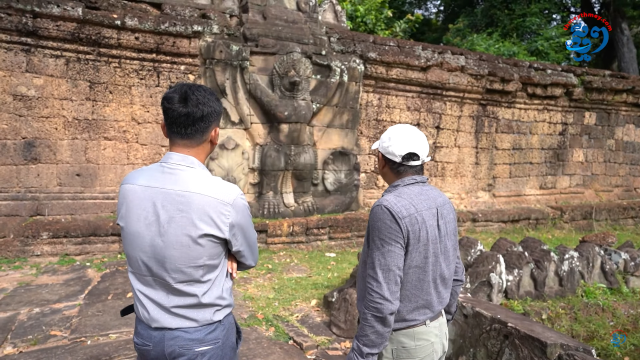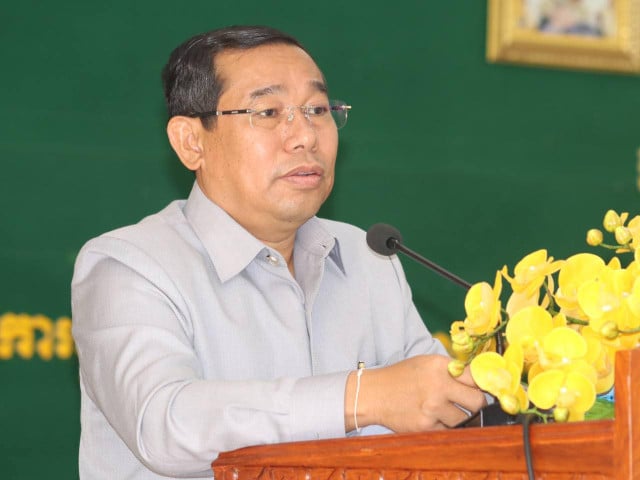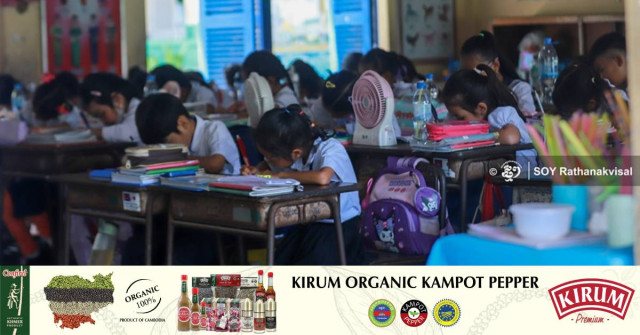Preah Khan: a Khmer Temple Displaying both Hindu and Buddhist Traditions

- By Sem Vanna
- August 5, 2023 2:30 PM
SIEM REAP — With its entrance decorated with human-sized sculptures similar to those in Angkor Thom city, the Preah Khan temple as it stands today combines Hindu and Buddhist features in harmony. But the history that led to its alterations during the Angkorian era was not always that harmonious.
Preah Khan, which translates as the “sacred sword,” was built in the late 12th century under the supervision of King Jayavarman VII, one of the most famous kings of the Khmer Empire. About 6.5 kilometers north of Angkor Wat temple, Preah Khan is also a main tourist attraction in the Angkor Archeological Park—a Unesco’s World Heritage Site—in Siem Reap province.
_1691201851.png)
However, before walking into this temple, one might notice something quite unusual that may raise questions: sculpted stones with empty cavities. What happened to these stones? Were they deliberately damaged? And why?
According to Chea Sarith, an archaeologist with the APSARA National Authority—the government agency in charge of Angkor Park—this was due to a change of regime in the kingdom.
Sem Vanna: Looking at the prominent pillar-like structure at the entrance of the temple, we can see empty cavities where were sculpted images of the Buddha that were chipped away. Why did this happen? How could images of a divine figure be erased?
_1691201508.png)
Chea Sarith: To cut a long story short, it was because of the changing of religion. The temple of Preah Khan was constructed by the famous King Jayavarman VII. This monastery was mainly dedicated to Mahayana Buddhism. That is one of the reasons why the sima [pillars marking the monastery boundaries] here were decorated with images of Buddha on their four corners at the entrance of the temple. If my memory does not fail me, there are a total number of 100 simas, 50 on each side…only one sculpture of Buddha survived the change and fortunately we can still see it right here. If not chipped away, the images of Buddha were also reworked and edited into depictions of Shiva lingam.
_1691201592.png)
Sem Vanna: When did the change happen?
Chea Sarith: The transformation perhaps occurred in the mid-13th century when his successor, Jayavarman VIII, walked away from Buddhism. This did not only happen at Preah Khan. The temples of Ta Prohm, Banteay Kdei and others were also subjected to this change. When entering Preah Khan, we can also see newer buildings that were constructed for Hinduism. It was not that rare at the time. [During the Angkorian era, changes of state religion would occasionally take place depending on the king who had acceded to the throne].
_1691201681.png)
Sem Vanna: If the temple was built for Buddhism, why are there large sculptures of Garuda? This Hindu figure, a mythical eagle-like bird, is the vehicle of Lord Shiva [one of the main, and for many the main, among Hindu deities].
Chea Sarith: King Jayavarman VII was trying to unite the two religions at that time. Even though he practised Buddhism, the king also showcased many Hindu similarities on these monuments. At the same time, the figure of Garuda here represents bravery, strength and protection. Preah Khan was a temporary city for King Jayavarman VII before he moved to the walled city of Angkor Thom. He built Preah Khan to remind his subjects of his victory over the Chams. However, if you look even closer, there are also sculptures of Buddha on top of the Garuda. This blend signifies his attempt to bring the two religions into harmony.
_1691201731.png)
Interviewed in Khmer for ThmeyThmey News, this story was translated by Ky Chamna for Cambodianess.
Related article: Twenty Years of Restoring Angkor Archeological Park
To watch the interview in Khmer, click here















